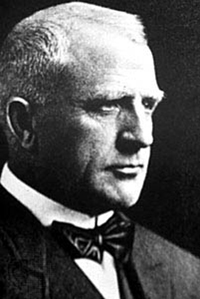January 1884: First U.S. Patent for a Roller Coaster
 LaMarcus Thompson. |
The unquestioned highlight for most people of any visit to an amusement park is the roller coaster, affectionately dubbed the "Great American Scream Machine." But coasters are more than just mere entertainment. They are based on fundamental physics principles such as gravitation, centripetal force, and acceleration. As such, roller coasters have become one of the most popular mechanisms for teaching these basic concepts to students.
Largely considered an American phenomenon, roller coasters actually have their roots in the ice slides that first appeared in the 17th century in Russia, near St. Petersburg. They were built out of lumber covered with a sheet of ice severaljjjlkkkkk inches thick, and featured drops of 50 to 80 feet. They were a big favorite among the Russian upper class—Catherine the Great is said to have been a fan, and even had a few built on her estate.
Most historians credit the French with building the first wheeled coaster—by 1817 there were two coasters in France, both of which featured cars locked to the track—and with building the first looping coaster at Frascati Gardens in Paris. An early attempt to bring a similar ride to the US in 1848 failed because of an accident during the trial run. It would fall to an American inventor named LaMarcus Thompson to revolutionize the amusement industry in the US, earning him the title of the "father of the American roller coaster."
Born in 1848 in Jersey, Ohio, Thompson was a natural at mechanics, designing and building a butter churn and an ox cart when he was 12. He attended Hillsdale College in Michigan and then worked briefly in the wagon and carriage business before making his fortune as a manufacturer of women' s seamless hosiery. After selling his stake in the hosiery business, he turned back to his first love: inventing.
Several years earlier he had ridden on the Mauch Chuk Switchback Railway in Pennsylvania, a former mine track used to transport coal down a mountainside that had become a popular tourist attraction. He decided to build his own Gravity Pleasure Switchback Railway at Coney Island, completed in 1884.
It was the first bona fide roller coaster to be built in the US, shaped like the early Russian ice slides (two hills parallel to each other), incorporating undulating hills and a flat steel track nailed onto several layers of wooden plank, connected to two 45 foot towers.
The maximum speed was 6 mph, and the cars had to be manually towed to the top of the hills at the start of both tracks. Nevertheless, the ride was an instant success with the public. Within four years, Thompson had built approximately 50 more coasters across the nation and in Europe, and then began work on what became his most famous attraction, the Scenic Railway, designed with James A. Griffiths.
It opened in 1887 in Atlantic City and featured artificial scenery illuminated by lights triggered by the approaching cars—a precursor to the elaborate theme park rides at Disneyland and other parks today.
Thompson built numerous other scenic railways until his retirement in 1915. He died in 1919.
Of course, Thompson was not the only early designer of roller coasters, either in the US or abroad, and improvements and innovations were quickly made.
In 1884, Charles Alcoke designed a coaster with a continuous track, so that the ride ended where it began, and the following year Phillips Hinckle used a mechanical hoist to raise the cars to the top of the hill, rather than being towed manually. That same year saw the debut of the first experiment with loops with the Flip Flap, which rolled cars through a 25 foot diameter circular loop, but closed in 1903 because of the frequent neck and back injuries suffered by its passengers.
By the end of the 19th century, all the basic elements of the modern roller coaster were in place, although they were slow.
The early 1900s featured numerous innovations in roller coaster design, led by the rides at Coney Island, the success of which ultimately spawned the opening of amusement parks worldwide.
The 1920s was the "Golden Age" of roller coaster design and innovation, with more than 1500 rides opening in North America, and another 1500 overseas. But the Great Depression caused the number of roller coasters to decrease and many amusement parks to be torn down.
The technology languished until 1955, when the opening of Disneyland in southern California ushered in a new Golden Age for the roller coaster. Since then, further innovations have come fast and furious—new track elements, launch systems, seating, and elaborate ride themes—and today, roller coasters are more popular and pervasive than ever.
Further Reading:
Adams, Judith A. The American Amusement Park Industry: A History of Technology and Thrills (Boston: Twayne Publishers, 1991).
Cartmell, Robert. The Incredible Scream Machine: A History of the Roller Coaster (Bowling Green: Bowling Green State University Popular Press, 1987).
Online Resources:
• http://www.ultimaterollercoaster.com
• Build your own roller coaster: http://www.learner.org/exhibits/parkphysics/coaster.html
• http://www.fearofphysics.com/Roller/roller.html
• http://dsc.discovery.com/convergence/coasters/coasters.html
• PC Simulation software available at : http://nolimitscoaster.com
©1995 - 2024, AMERICAN PHYSICAL SOCIETY
APS encourages the redistribution of the materials included in this newspaper provided that attribution to the source is noted and the materials are not truncated or changed.
Associate Editor: Jennifer Ouellette
January 2004 (Volume 13, Number 1)
Articles in this Issue

